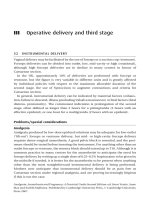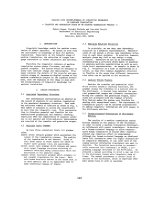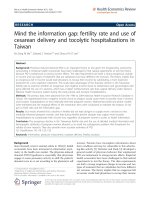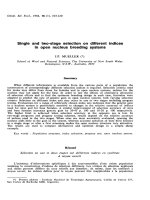Operative delivery and third stage
Bạn đang xem bản rút gọn của tài liệu. Xem và tải ngay bản đầy đủ của tài liệu tại đây (145.64 KB, 30 trang )
III Operative delivery and third stage
32 INSTRUMENTAL DELIVERY
Vaginal delivery may be facilitated by the use of forceps or a suction cup (ventouse).
Forceps deliveries can be divided into outlet, low, mid-cavity or high (rotational),
although high forceps deliveries are in decline in many centres in favour of
Caesarean section.
In the UK, approximately 10% of deliveries are performed with forceps or
ventouse, but the figure is very variable in different units and is greatly affected
by individual policies with respect to the maximum allowable duration of the
second stage, the use of Syntocinon to augment contractions and criteria for
Caesarean section.
In general, instrumental delivery can be indicated by maternal factors (exhaus-
tion, failure to descend, illness precluding Valsalva manoeuvre) or fetal factors (fetal
distress, prematurity). The commonest indication is prolongation of the second
stage, often defined as longer than 2 hours for a primigravida (3 hours with an
effective epidural), or one hour for a multigravida (2 hours with an epidural).
Problems/special considerations
Analgesia
Analgesia produced by low-dose epidural solutions may be adequate for low-outlet
(‘lift-out’) forceps or ventouse delivery, but mid- or high-cavity forceps delivery
requires dense surgical anaesthesia. A good pelvic block is essential, and the peri-
neum should be tested before inserting the instrument. For anything other than an
outlet forceps or ventouse, the sensory block should extend up to T10. Although it is
common practice in many centres for the anaesthetist to anticipate the need for
forceps delivery by writing up a single dose of 0.25–0.5% bupivacaine to be given by
the midwife if needed, it is better for the anaesthetist to be present when anything
other than the most straightforward instrumental delivery is being performed.
Mothers now anticipate that instrumental delivery should be as pain free as
Caesarean section under regional analgesia, and are proving increasingly litigious
if this is not the case.
Analgesia, Anaesthesia and Pregnancy: A Practical Guide Second Edition, ed. Steve Yentis, Anne
May and Surbhi Malhotra. Published by Cambridge University Press. ß Cambridge University
Press 2007.
Trial of forceps
When it is anticipated that instrumental delivery may be difficult, provision should
be made for immediate conversion to Caesarean section. The procedure should
be carried out in the operating theatre and regional anaesthesia should be adequate
for rapid operative delivery.
Aftercare
It should be remembered that the extensive episiotomy that usually accompanies
instrumental delivery, coupled with the inevitable tissue trauma, often results
in significant pain in the immediate postpartum period. Non-steroidal anti-
inflammatory drugs should be used prophylactically if there are no contraindica-
tions, and epidural opioids may be required. Postpartum haemorrhage can result
from cervical or vaginal tears.
Instrumental delivery and regional analgesia
There is no doubt that, in most centres, there is a higher rate of instrumental deliv-
ery in mothers who opt for regional analgesia. Although it is very difficult to exclude
potential confounders (e.g. it is likely that women who need epidural analgesia are
those with other factors that predispose to instrumental delivery, such as slow
progress, malpresentation, multiple gestation, relative cephalopelvic disproportion
etc.) a causal link cannot be excluded. This must be weighed against the improved
quality of analgesia compared with alternatives, the beneficial effect of epidural
analgesia on fetal acid–base balance, and the ability to avoid general anaesthesia
in many cases should Caesarean section be required.
Management options
For deliveries other than outlet forceps and ventouse, with a functioning epidural
in situ, it is an easy matter to intensify the block by administering a solution such as
10 ml of 0.25–0.5% bupivacaine. Pelvic spread may be encouraged by sitting the
mother up, and it is therefore important to establish the block before putting the
legs into stirrups. A small dose of fentanyl may help to provide perineal analgesia
if spread is recalcitrant.
Where no epidural is in place, spinal anaesthesia is most appropriate, using
a dose in the region of 1.5 ml of hyperbaric 0.5% bupivacaine in the sitting
position, +10–15 mg fentanyl. Other than in exceptional circumstances, general
anaesthesia should not be used, since it does not allow the mother to cooperate
by pushing at the right time and is an excessively invasive approach for a relatively
minor procedure.
Pudendal block may be performed by the obstetrician if there is no anaesthetist
available or if the mother is already prepared in the lithotomy position. The tech-
nique has considerable drawbacks, however, having a high failure rate and needing
at least 10–20 minutes to become effective. Pudendal block may also be used
to supplement an existing epidural with sacral sparing, and infiltration of the
32 Instrumental delivery 81
perineum with local anaesthetic is a useful adjunctive technique before performing
an episiotomy.
In all cases, care must be taken to ensure that aortocaval compression is avoided,
e.g. by tilting the mother’s pelvis with a wedge.
Key points
• A good pelvic block is essential and should be confirmed by testing.
• Conversion to Caesarean section may be required.
• Anaesthesia should be established before elevating the legs.
FURTHER READING
Liu EH, Sia AT. Rates of caesarean section and instrumental vaginal delivery in nulliparous
women after low concentration epidural infusions or opioid analgesia: systematic review.
BMJ 2004; 328: 1410–12.
33 CAESAREAN SECTION
The Caesarean section (CS) rate in the UK in 2004–5 was $23% (about one-third
‘elective’ – see below), though with wide regional variation. There has been general
concern over the increasing CS rates in most developed countries and the
associated complications, notwithstanding the benefits that CS might also have
in individual cases. Since CS is such an important procedure in obstetrics,
and anaesthetic-related maternal deaths commonly involve emergency CS, it is
important that obstetric anaesthetists have an understanding of the practical
aspects relating to obstetric indications and techniques.
Classification and delivery time
Traditionally, CS has been classified as elective (i.e. a date is given beforehand)
or emergency (the rest). The latter group is thought by many obstetricians and
obstetric anaesthetists to be too broad, since it includes cases in which immediate
delivery is required (e.g. severe fetal compromise or cord prolapse) as well as cases
in which there is little urgency (e.g. early spontaneous labour in a mother with
a breech scheduled for elective CS the next day). This has led to reclassification
of CS into four grades (Table 33.1); this classification has been adopted by all
the major UK bodies involved in this field. Although intended as an audit tool
(e.g. to monitor outcomes and allocation of staff), the classification has been
used to guide management (e.g. second operating theatre opened for grade-1
cases). However, attempts to link the grades to acceptable maximum times to
delivery (e.g. 15 min for grade 1) are hampered by the unwillingness of
obstetricians to commit themselves to ‘acceptable’ delays for grades 2 and 3 in
82 Section 2 – Pregnancy
case of a bad outcome. In addition, maximum times to delivery are controversial
and not based on good science: the often quoted maximum of 15–30 minutes for
fetal compromise is derived largely from work in the 1960s in which animal fetuses
were exposed to varying durations of intrauterine hypoxia and the degree of sub-
sequent fetal damage assessed. Most cases of cerebral palsy are now known to be
related to factors arising before labour. A number of audits within maternity units
have found that meeting the particular standard set is extremely difficult to achieve
in practice because of delays at each stage of the process (e.g. calling the anaes-
thetist/anaesthetic assistant, moving the mother to the operating theatre, preparing
the surgical equipment, etc.). Finally, the defined time period itself varies: the time
from decision to skin incision; from decision to delivery; and from informing the
anaesthetist to skin incision or delivery have all been quoted in various recommen-
dations or guidelines.
More recently, analysis of data from the Royal College of Obstetricians and
Gynaecologists’ Sentinel audit of CS in the UK suggests that poorer maternal and
neonatal outcomes are associated with decision-to-delivery intervals exceeding
75 minutes, but not intervals of 31–75 minutes. Nevertheless, 30 minutes has
repeatedly been recommended as an ‘audit standard’.
Indications
CS may be performed for the benefit of the mother, the fetus or both (Table 33.2),
although in practice maternal indications will ultimately affect the fetus adversely
if not relieved, and vice versa. For elective CS, 39 weeks is commonly chosen as
the optimum gestation, reflecting a balance between the benefit to the neonate of a
longer gestation and the greater risk of spontaneous labour and emergency surgery.
Procedure
For lower segment CS, skin incision is usually low transverse (i.e. in the L1 derma-
tome) but may be midline. Once exposed, the rectus sheath is split longitudinally
Table 33.1. Classification of Caesarean section
1 Immediate threat to life of woman or fetus
2 Maternal or fetal compromise which is not immediately life-threatening
3 Needing early delivery but no maternal or fetal compromise
4 At a time to suit the woman and maternity team
N.B. applies to the time of decision to operate; e.g. an episode of fetal compromise caused by
aortocaval compression responding to therapy, followed some hours later by Caesarean
section for failure to progress, would be graded as 3, not 2. Similarly, a case booked as an
elective procedure for malpresentation could eventually be classified as grade 3 if the mother
goes into labour before the chosen date of surgery. Also applies whether or not the woman is
in labour.
33 Caesarean section 83
and stretched laterally and the peritoneum incised. The uterus is incised trans-
versely in its thin lower segment. A ‘classical’ CS involves a midline incision, and
the uterus is incised longitudinally in its upper segment. Classical CS is associated
with a greater risk of haemorrhage, infection and ileus but is quicker to perform and
easier than lower segment CS. It may be indicated if the lower segment is poorly
formed (e.g. in premature delivery), or in placenta praevia, transverse/unstable lie
or uterine fibroids.
Uterine incision is accompanied by removal by suction of amniotic fluid if the
membranes have not ruptured (mothers and partners may find the noise alarming if
unexpected). Delivery of the baby may be difficult if the head has descended well
into the pelvis, and may require forceps. If the placenta has already started to sep-
arate, the uterus may contract around the baby’s head; increased inspired concen-
tration of volatile agent has been used to relax the uterus during general
anaesthesia; glyceryl trinitrate 50–100 mg intravenously or sublingually, repeated
as necessary, has also been used to good effect.
The time between induction of general anaesthesia and delivery (I–D interval)
may affect fetal wellbeing since, if very short, the induction agent may be present
in the fetus at high levels; if the interval is very long, fetal accumulation of inhala-
tional agents may occur. The time from uterine incision to delivery (U–D interval)
is thought to be more important, since placental disruption may occur once
the uterus is incised; fetal acidosis is unlikely if the U–D interval is less than
3 minutes.
Following delivery of the baby, oxytocin is given (5 U slowly intravenously).
Rapid injection of larger doses may cause severe tachycardia and may be no
more effective than smaller doses. Uterine contraction may be aided by vigorous
rubbing of the uterus; an oxytocin infusion may be required (e.g. 40 U in 500 ml
saline at 100 ml/h), especially after prolonged augmented labour, multiple delivery,
Table 33.2. Indications for Caesarean section
Previous Caesarean section
Elective
Following trial of labour
Other
Maternal disease
Worsening pre-existing disease, e.g. cardiac
Associated with pregnancy, e.g. pre-eclampsia
Placenta praevia or abruption
Maternal exhaustion/choice
Obstructed labour/failure to progress
Malpositions
Multiple pregnancy
Fetal compromise
Cord prolapse
84 Section 2 – Pregnancy
in the presence of polyhydramnios and with a previous history of postpartum
haemorrhage or multiple deliveries.
Once the baby and placenta have been delivered, the uterus is checked for tears
and sutured. Many obstetricians prefer the ease of access conferred by exteriorising
the uterus, although this may be accompanied by discomfort and nausea/vomiting
during regional anaesthesia, bradycardia and increased incidence of air embolism.
The obstetrician should always check with the anaesthetists before performing this
manouevre.
Problems/special considerations
• Surgical problems relating to the procedure itself include difficulty caused
by adhesions (especially following previous CS or other abdominal surgery),
haemorrhage, surgical trauma to the baby, difficulty delivering the baby
with the risk of fetal hypoxia or physical trauma, difficulty delivering the
placenta and damage to neighbouring structures. There may be large veins on
the anterior wall of the uterus and wide transverse incisions may extend to the
uterine angles when the baby is delivered, leading to severe bleeding. Usual blood
loss is $400–700 ml (increased with general anaesthesia) but is notoriously
difficult to estimate accurately. There is an increased risk of placenta accreta
in women who have had previous CS, especially if the placenta overlies
the previous scar. Overall the risk of further surgery is increased from
$3 per 10 000 after CS to $50 per 10 000 after vaginal delivery, with the risk of
hysterectomy increased from 1–2 per 10 000 to up to 80 per 10 000 (though
it isn’t clear how much the reason for CS may also influence the need for further
surgery).
• Anaesthetic problems include those of general or regional anaesthesia generally.
Pain during CS under regional anaesthesia has replaced awareness under general
anaesthesia as the main reason for litigation associated with CS. Chest pain and/
or electrocardiographic changes may occur; their cause is unknown (although
small air emboli or coronary artery/oesophageal spasm has been suggested)
and they may occur independently of each other. Elevations of maternal troponin
I levels have also been reported. Shoulder-tip pain may occasionally occur,
probably related to blood irritating the diaphragm. Other possible problems
related to the procedure include air or amniotic fluid embolism and allergic
phenomena.
• Postoperative problems are as for any surgery and include infection (prophylactic
antibiotics have been shown to reduce infection and should be given) and
thromboembolism (heparin is given prophylactically to women at high risk in
some units and to all women in others). If the former, the Royal College of
Obstetricians and Gynaecologists’ guidelines should be followed. National
Institute of Clinical Excellence guidelines suggest that observations (including
assessment of pain and sedation) should be half-hourly for 2 hours after CS,
then 1–2 hourly.
33 Caesarean section 85
Management options
The choice of anaesthetic technique depends on the degree of urgency, whether
an epidural catheter is already in place, specific obstetric (e.g. complicated
surgery anticipated) or anaesthetic (e.g. known difficult intubation, previous
back surgery) factors, the personal preference of the anaesthetist and the
wishes of the mother (see Chapters 34–36). Absolute figures are unavail-
able, but it is thought that 490% of CS are performed under regional anaesthesia
in the UK, reflecting the above preferences and the widely perceived greater safety
of regional over general anaesthesia for CS. Particular concerns are the
possibly inadequate exposure of anaesthetic trainees to general anaesthesia
for CS, the greater tendency of trainees to use general anaesthesia (especially
for emergency CS) than more experienced consultants, and the anxiety
caused when this occurs. There is also concern that the incidence of failed
intubation in obstetrics is increasing and that this may be related to the above
factors.
Key points
• Caesarean section rate in the UK is $23%.
• Indications may be maternal, fetal or both.
• Complications include shoulder-tip, abdominal or chest pain, air or amniotic fluid
embolism, haemorrhage, surgical trauma and awareness.
FURTHER READING
Lucas DN, Yentis SM, Kinsella SM, et al. Urgency of Caesarean section: a new classification.
J R Soc Med 2000; 93: 346–50.
National Institute for Clinical Excellence. Clinical guideline 13: caesarean section. London:
NICE 2004.
Shibli KU, Russell IF. A survey of anaesthetic techniques used for caesarean section in the UK
in 1997. Int J Obstet Anesth 2000; 9: 160–7.
Yentis SM. Whose distress is it anyway? ‘Fetal distress’ and the 30-minute rule. Anaesthesia
2003; 58: 732–3.
34 EPIDURAL ANAESTHESIA FOR CAESAREAN SECTION
Although no longer the technique of choice for elective Caesarean section, the pop-
ularity of epidural analgesia for pain relief in labour means that many women
presenting for emergency Caesarean section have an epidural in situ. A greater
understanding of methods to enhance the speed of onset and quality of epidural
block has reduced the need for general anaesthesia in this group of mothers;
extension of the block is the technique of choice, unless epidural analgesia
86 Section 2 – Pregnancy
during labour has been of poor quality or there is a very urgent indication for
delivery within 5–10 minutes.
Problems/special considerations
• Poor block with breakthrough pain is more common than with spinal anaesthe-
sia, and a careful assessment of block is therefore particularly important in this
group. Whereas in spinal anaesthesia it is reasonable to assume that the block is
consistent between the upper and lower limits, this is not the case with an
epidural. The block should be ‘mapped out’ to ensure that there are no missed
segments or patchy areas and the extent of block carefully recorded. The mother
must be warned of the risk of pain before starting the procedure, and the anaes-
thetist should be prepared to supplement the block with further top-ups,
intravenous analgesia or even general anaesthesia. Pain during Caesarean section
is the commonest failure cited in negligence suits against obstetric anaesthetists
in the UK.
• Hypotension is slower in onset and normally less severe than with spinal anaes-
thesia, but vasoconstrictors are still frequently required, and great care should
be taken to avoid aortocaval compression.
• The possibility of migration of the epidural catheter, whether into the subdural,
intrathecal or intravenous compartments, must be borne in mind, especially
when large, concentrated doses of local anaesthetic are being used. Doses
should be fractionated or given by slow injection and the level of block regularly
checked. It is unacceptable to leave a mother for any reason once the process of
establishing the block has started.
Management options
Suitability of the technique
Unlike spinal anaesthesia, the operation cannot be started as fast as if general
anaesthesia is used. In the true emergency, therefore, such as massive placental
abruption or prolapsed cord, spinal or general anaesthesia remains the technique
of choice. Having said this, the use of a bolus dose of 15–20 ml concentrated
solution (e.g. bupivacaine 0.5% or lidocaine 2%) over 2–3 minutes can convert a
moderate T10 block to a block suitable for surgery within about 10–15 minutes
in most cases. Use of carbonated solutions and mixtures of lidocaine and bupi-
vacaine have been shown to speed onset for elective Caesarean section, but
clinical trials in emergency Caesarean section are few. It is clear that there is
considerable variation in onset times between patients. Slow injection of a
bolus necessitates cutting corners, with the precautions mentioned above about
fractionating doses. The risks and benefits to the mother and fetus of epidural
versus general anaesthesia in these circumstances must be carefully consid-
ered, and these can be among the most difficult clinical decisions taken by
anaesthetists.
34 Epidural anaesthesia for Caesarean section 87
A ‘fresh’ spinal anaesthetic may be preferable to attempting to top up a poorly
functioning epidural catheter, since the chance of inadequate anaesthesia during
surgery is greater if analgesia has been poor during labour. Also, if extension of the
epidural proves to be inadequate and a spinal anaesthetic is then chosen, the spread
of the spinal dose may be more unpredictable after large volumes of solution
have already been injected epidurally.
Contraindications to epidural anaesthesia are discussed in Chapter 35, Spinal
anaesthesia for Caesarean section (p. 90). In practice, there are very few mothers
in whom an epidural cannot be ‘topped up’ for operative delivery.
Preoperative preparation
This is also discussed in Chapter 35, Spinal anaesthesia for Caesarean section
(p. 90). It is particularly important in these patients to mention the risk of intra-
operative pain and to have a plan to deal with this should it occur. Because of the
occasional need for general anaesthetic supplementation, full antacid precautions
must be employed; these should include oral sodium citrate and an intravenous
H
2
antagonist in the emergency situation. Assessment of the airway for possible
intubation difficulty is also mandatory. Prophylactic vasopressors are rarely needed
but should be available, and a large-bore intravenous cannula must be inserted
to allow rapid fluid infusion.
Choice of drugs
Bupivacaine 0.5% has been the mainstay for many years for epidural Caesarean
section, but large doses (often in excess of the recommended upper limits) are
frequently required, and the block may not be ideal. Lidocaine 2% has a faster
onset for elective cases, but the volumes required mean that adrenaline must be
added to minimise systemic absorption. In both cases, volumes in the region of
20–25 ml are usually needed to establish a sufficiently extensive block. Slow bolus
injection (including through the needle) has been shown to produce more rapid
and reliable block (with lower final volumes) than boluses of 5 ml repeated every
5–10 minutes, but with attendant risks if the injection is misplaced. Carbonated
solutions of bupivacaine and lidocaine have been shown to produce a more
rapid onset of a denser block for elective and emergency Caesarean section
respectively. A ‘recipe’ consisting of 10 ml 0.5% bupivacaine, 10 ml 2% lidocaine,
0.1 ml 1:1000 adrenaline and 2 ml 8.4% bicarbonate is often used; when given over
3 minutes to supplement an effective labour epidural, 15–20 ml of this solution
will usually produce a bilateral block to T4 to cold within 8–10 minutes. However,
it has been argued that this practice increases the risk of drug errors during
mixing, and preparation of fresh solution itself delays injection and thus onset
of block. Ropivacaine and levobupivacaine appear to have no advantage over
bupivacaine other than improved toxicity. Fentanyl 50–100 mg is often added,
although it is uncertain whether this is useful if regular doses have been given
during labour, and intra-operative nausea and vomiting may be increased.
88 Section 2 – Pregnancy
Administration of the epidural anaesthetic
If a catheter is being sited de novo, it is often best done on the labour ward or in
a suitable area outside the operating theatre, since the slower onset of epidural
anaesthesia would otherwise mean that the mother would have to lie on the oper-
ating table for some time while waiting for the block to take effect. In most cases the
epidural catheter is already in situ; if this is the case, then it has been argued that the
epidural may be topped up in the delivery room before transfer, thus saving what
may be important time. This practice is controversial, however, since the delivery
room is not an ideal place for dealing with extensive block, severe hypotension or
local anaesthetic toxicity. The anaesthetist must, of course, remain with the mother
from the point of topping up an epidural with concentrated solutions, wherever this
is done, and ensure adequate monitoring.
Testing the block
Because of the possibility of missed segments and unilateral block, the extent of
sensory loss should be mapped with great care, including sacral segments. The
upper and lower levels on both sides should be determined and the intermediate
dermatomes tested also. Bilateral lower limb motor block is a useful indicator of
adequate sacral spread and should be confirmed before starting the operation;
sacral sparing may be treated with epidural fentanyl 50 mg. A block to cold from
T4 to S5, with loss of touch sensation up to T5, should be the target, and the extent of
the block must be documented. The epidural catheter allows further doses to be
given, and appropriate positioning of the patient, although not as effective as with
spinal anaesthesia, may encourage spread into recalcitrant areas.
During the operation
Hypotension is rarer than with spinal anaesthesia, but blood pressure should be
carefully monitored and treated expeditiously. Inadequate block may become
apparent during peritoneal incision, and exteriorisation of the uterus, a manoeuvre
much favoured by certain obstetricians, is often poorly tolerated. A delicate surgeon
can make all the difference if the block is borderline, and good communication
between medical staff is rarely more important. Nausea and vomiting, if associated
with vagal stimuli such as exteriorisation of the uterus or peritoneal manipulation,
may be treated with glycopyrronnium 200–600 mg.
After the operation
If opioids have not been given, an epidural dose of a long-acting, lipid-soluble drug
such as diamorphine 2–3 mg may be given along with oral/rectal non-steroidal
analgesics if not contraindicated. The same precautions regarding discharge from
recovery and monitoring should be followed as for spinal anaesthesia. The epidural
catheter lends itself to further low-dose local anaesthetic/opioid top-ups or infu-
sion, but this can only be done if there are facilities and staff to care for the patient
safely. These should be similar to those that are available for mothers with an
epidural in labour.
34 Epidural anaesthesia for Caesarean section 89
Key points
• The full extent of the block must be tested.
• Pain during the operation is more common than with spinal anaesthesia, and the
patient must be warned.
• Slow-bolus epidural injection may be used to produce a good quality block within
10–15 minutes but may be more hazardous than fractionated injection.
FURTHER READING
Lam DT, Ngan Kee WD, Khaw KS. Extension of epidural blockade in labour for emergency
Caesarean section using 2% lidocaine with epinephrine and fentanyl, with or without
alkalinisation. Anaesthesia 2001; 56: 790–4.
Lucas DN, Ciccone GK, Yentis SM. Extending low dose epidural analgesia for emergency
Caesarean section–a comparison of three solutions. Anaesthesia 1999: 54: 1173–7.
Pan PH, Bogard TD, Owen MD. Incidence and characteristics of failures in obstetric neuraxial
analgesia and anesthesia: a retrospective analysis of 19,259 deliveries. Int J Obstet Anesth
2004; 13: 227–33.
Patel M, Craig R, Laishley R. A comparison between epidural anaesthesia using alkalinized
solution and spinal (combined spinal/epidural) anaesthesia for elective caesarean section.
Int J Obstet Anesth 1996; 5: 236–9.
Sanders SD, Mallory S, Lucas DN, et al. Extending low-dose epidural analgesia for emergency
caesarean section using ropivacaine 0.75% Anaesthesia 2004; 59: 988–92.
35 SPINAL ANAESTHESIA FOR CAESAREAN SECTION
In 1996, a survey of British obstetric anaesthetists showed that 74% would use
single-shot spinal anaesthesia as their first choice for elective or, if time permitted,
urgent Caesarean section; this technique therefore probably accounts for the
majority of all anaesthetics for Caesarean sections in the UK.
Problems/special considerations
• Rapid onset of widespread vasodilatation coupled with the effect of aortocaval
compression means that hypotension is an almost inevitable accompaniment to
spinal anaesthesia in the mother unless specific precautions are taken. Avoidance
of the supine position, frequent blood pressure measurement and instant avail-
ability of intravenous fluid and vasopressors are prerequisites for the safe use of
this technique.
• Careful assessment of the level of block is essential before starting the
operation. Despite an apparently adequate block, pain may still occur,
although this is less likely than if an epidural anaesthetic has been used.
Mothers should be warned of this possibility in advance, and adequate treat-
ment, even to the extent of inducing general anaesthesia, must be offered.
90 Section 2 – Pregnancy
Pain during Caesarean section under regional anaesthesia is currently the
commonest successful cause of litigation against obstetric anaesthetists in
the UK.
• The incidence of postdural puncture headache (PDPH) is related to the size and
type of needle used. ‘Pencil-point’ and conical tip needles, such as the Sprotte and
Whitacre, are associated with a much lower rate of headache than Quincke
needles with a cutting tip, so much so that a 24 G pencil-point needle is probably
better than a 27 G Quincke needle.
• Meningitis and encephalitis are extremely rare. However, once the dura mater has
been penetrated, the cerebrospinal fluid (CSF) is particularly susceptible to
contamination, and it is considered good practice to use a completely aseptic
technique, including the wearing of mask, gown and gloves.
Management options
Suitability of the technique
In experienced hands, spinal anaesthesia can be almost as fast as general anaes-
thesia, and there are few occasions when the urgency of the situation means
that there is no time for this technique. If the mother already has an epidural
in situ then, time permitting, this should be topped up in preference to estab-
lishing a new block. If time is short, a single-shot spinal has been suggested as
an alternative to general anaesthesia in a mother with an epidural in situ.If
spinal supplementation of an existing epidural block is thought appropriate, it
may be necessary to use a reduced dose, as there have been case reports of very
high blocks in these circumstances. Spinal anaesthesia is contraindicated in
patients with hypovolaemia, coagulation disorders (whether iatrogenic or patho-
logical) and systemic sepsis. Although regional anaesthesia has traditionally
been avoided if massive blood loss is expected, such as in the case of placenta
praevia, many modern anaesthetists would now use a spinal block in this situation,
particularly since uterine contractility is greatly enhanced if general anaesthesia
with volatile agents is eschewed.
Although traditionally favoured as being better for the baby than general
anaesthesia, there is evidence that spinal anaesthesia may be associated with
greater neonatal acidosis than after epidural or general anaesthesia, possibly
related to the rapidity of onset and cardiovascular changes. However, the rapid
onset and more profound block compared with epidural anaesthesia, and
the greater maternal safety profile compared with general anaesthesia, make
spinal anaesthesia the technique preferred by most obstetric anaesthetists for
Caesarean section.
Preoperative preparation
Full fasting and antacid precautions should be taken, and the preoperative assess-
ment should include bedside tests for difficult intubation, since general anaesthesia
may be needed, albeit rarely, if the block is unsatisfactory. An explanation of the
35 Spinal anaesthesia for Caesarean section 91









